- JP
- EN
Groupwide Adoption of Clean Energy
- LNG-Fueled Ferries
- Ammonia fueled vessels
- Ammonia FSRU
- Liquefied CO2 Carrier
- Marine Hydrogen Fuel Engine
- Wind Hunter Project
Japan's First LNG-Fueled Ferries "Sunflower Kurenai" and "Sunflower Murasaki"
MOL, along with MOL's group company MOL Sunflower Ltd., put in service Japan's first LNG-fueled ferries, "Sunflower Kurenai" in January 2023 and "Sunflower Murasaki" in April 2023. Two more LNG-fueled ferries soon follow the sisters and are planned to be in service in 2025.
These LNG-fueled ferries are parts of the MOL's second concept in "the next-generation vessel series", "ISHIN-Ⅱ" announced in 2009. ISHIN-II presented the concept of reducing environmental impact through the use of LNG fuel and reducing GHG emissions from logistics through modal shift. This is also one of the initiatives that MOL further developed and realized within the technological development project, "Senpaku ISHIN NEXT - MOL SMART SHIP PROJECT," which MOL newly launched in 2016.
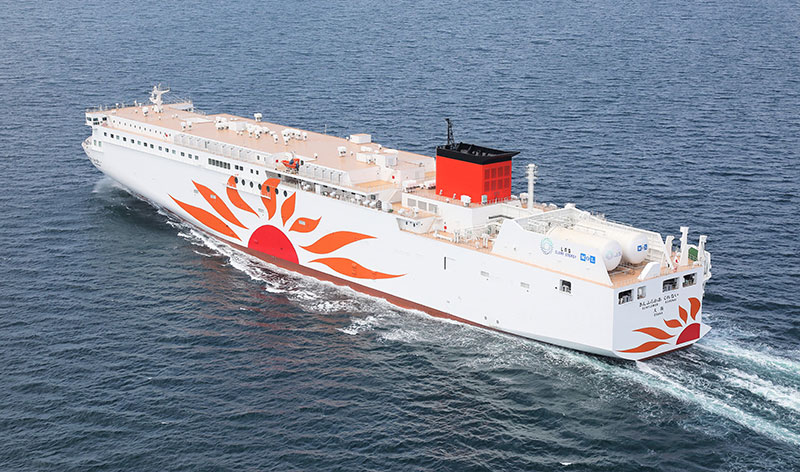
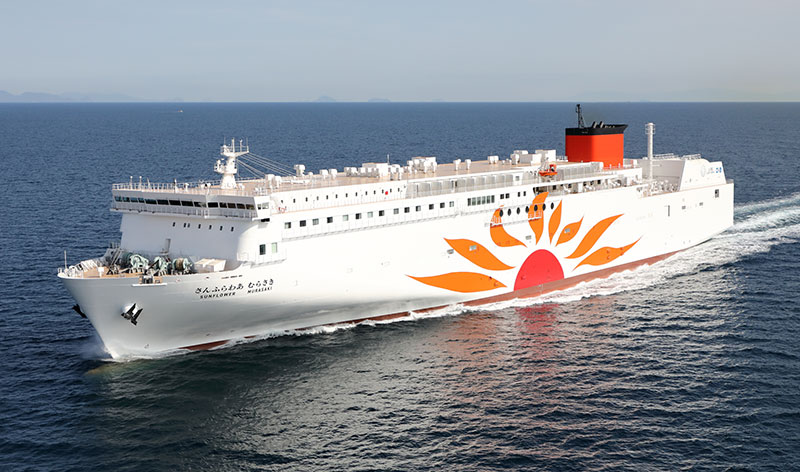
Joint Development of Ammonia fueled vessels
MOL is developing multiple basic designs of vessels equipped with main engines that can use ammonia as a fuel, in collaboration with industrial partners. The designs of a medium-sized liquefied gas carrier and a 210,000-ton bulk carrier were granted Approval in Principle (AiP).
Ammonia is expected to be a next-generation clean fuel with special precautions to be taken to ensure safety for its flammability, toxicity, and corrosiveness. MOL are conducting risk assessments for various elements of using ammonia as marine fuel and reflecting these in the basic designs. MOL is also actively participating in the discussion of making rules and regulations for use of ammonia as marine fuel.
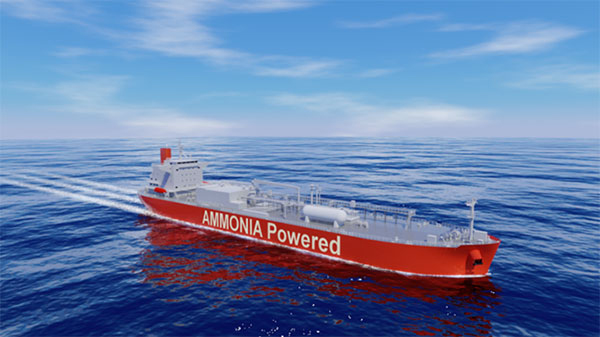
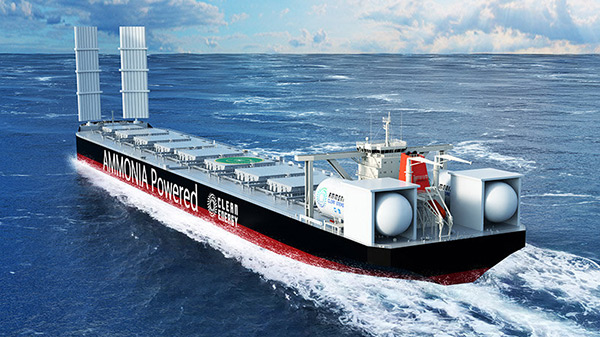
Concept Design of Ammonia FSRU
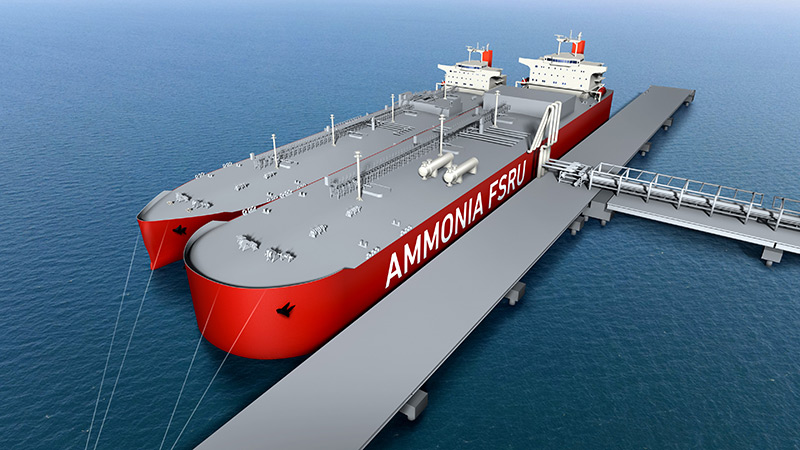
MOL is developing an Ammonia FSRU (Floating Storage and Regasification Unit) to support the promotion of ammonia as a next-generation clean fuel. The Ammonia FSRU is an offshore floating facility equipped with storage tanks and regasification facility, enabling the swift development of infrastructure to receive ammonia transported by sea.
MOL develops large ammonia carriers to meet the increasing demand for ammonia transportation and to provide high-quality, stable clean energy transportation. By extending this supply chain with the Ammonia FSRU, MOL supports the supply of clean energy with ammonia.
(*) FSRU stands for Floating Storage and Regasification Unit. MOL has worked on floating facilities that receive, store, and regasify liquefied natural gas (LNG) transported by sea and send it to land. Compared to building storage tanks and regasification facilities on land, FSRUs have the advantage of shorter construction periods and lower costs. This technology can be applied to ammonia receiving facilities, and is an enabler of the swift establishment of the ammonia fuel supply chain.
(*) Ammonia has traditionally been used as a raw material for fertilizers, and its maritime transport volume has been limited. However, it is now attracting attention as an efficient means of transporting hydrogen derived from renewable energy and as a clean fuel that does not emit carbon dioxide during combustion. A significant increase in demand is expected in the future.
Concept Design of "Liquefied CO2 Carrier" and "Ammonia/Liquefied CO2 Carrier"
MOL is developing various concepts for liquefied CO2 carriers. Among them, the concept of the "Ammonia/Liquefied CO2 Carrier" was developed to flexibly meet the future demand for transport of both liquefied CO2 and ammonia.
Based on the concepts of the "Liquefied CO2 Carrier" and "Ammonia/Liquefied CO2 Carrier," MOL is working on the development of various vessel types to flexibly respond to customer needs, considering the entire CCUS value chain to realize a low-carbon and decarbonized society.
(*) Liquefied CO2 carriers can play a key role in efficiently transporting liquefied CO2 to storage reservoirs or usage sites in the value chains of CCUS, which is drawing attention as a means realizing a low-carbon and decarbonized society.
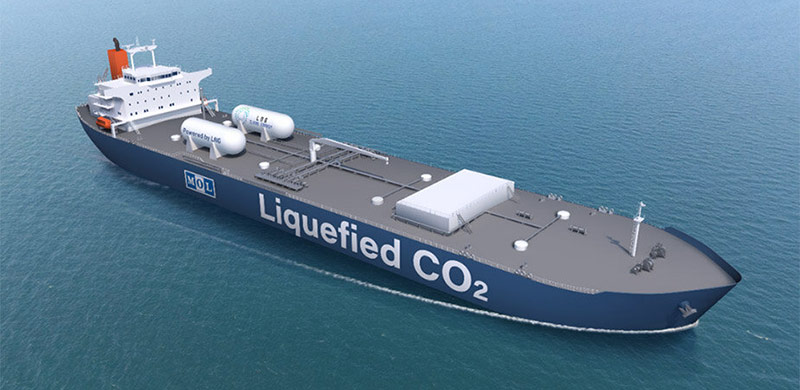
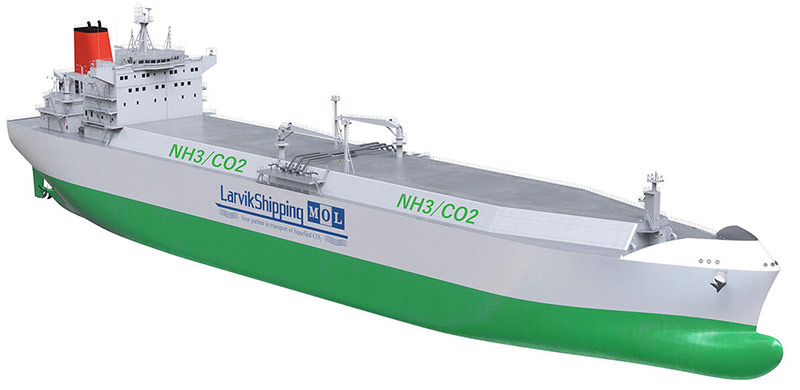
Onboard Demonstration of Marine Hydrogen Fuel Engine
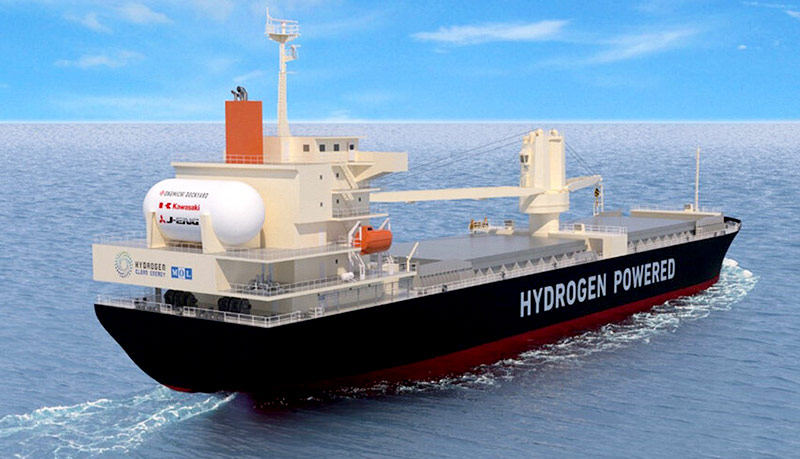
MOL is working together with Japan Engine Corporation for its development of the world's first marine low-speed two-stroke hydrogen fueled engine. MOL along with MOL Drybulk will install a hydrogen fueled engine developed by Japan Engine Corporation on one of our operating vessels and conduct a demonstration operation.
Hydrogen fuel is considered for use in various industries, including land-based plants, industrial machinery, and automobiles. It is also expected as a next-generation fuel option to reduce environmental impact from the maritime transport.
(*) Japan Engine Corporation, together with Kawasaki Heavy Industries, Ltd. and Yanmar Power Technology Co., Ltd., has been selected for the Green Innovation Fund Project by the New Energy and Industrial Technology Development Organization (NEDO) and is developing the world's first hydrogen fueled engine for large ocean-going and coastal vessels.
Wind Hunter Project

The Wind Hunter Project is a research project that advances the Wind Challenger Project, aiming to develop a zero-emission vessel concept.
The concept of Wind Hunter is to equip the ship with a large number of Wind Challenger-type sails, allowing it to sail by wind power without the need for fossil fuels. Additionally, as the vessel moves by wind power, underwater turbines generate electricity, which is used to produce hydrogen from seawater through electrolysis, storing it onboard.
We are currently working on proving the principle and studying the design of the vessel and elements for scaling up, aiming for future demonstrations on large vessels.
- Sustainability TOP
- Message from the Chief Sustainability Officer
- Sustainability
Management - Value Creation
Stories - Safety & Value
- Environment
- Human & Community
- Innovation
- Governance
- Stakeholder
Engagement - Sustainable Finance
- Sustainability Data
- ESG Disclosure
Guideline Indexes - External Recognition
- Library




